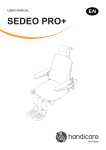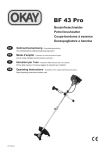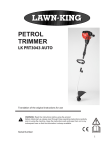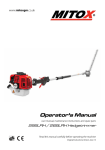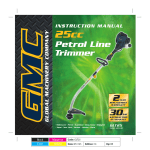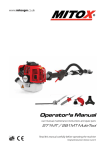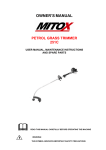Download MacAllister MGTP254 Operator`s manual
Transcript
Grass Trimmer MGTP254 OPERATOR’S MANUAL WARNING: read thoroughly the instruction booklet before using this machine ENGLISH - Original Instructions .................................................................... EN i 1 2 2 7 6 1 4 5 5 4 3 3 7 2 1 4 5 4 5 STOP 1 RUN START 3 2 1 2 4 6 5 CHOKE RUN 6 ii 8 10 9 12 11 1 3 2 2 13 0,5 mm iii 2 x 2,7 m (106 in.) 14 Ø 1,8 mm 120 mm (4,75 in.) 15 3 2 1 iv INTRODUCTION EN 1 Dear Customer, thank you for choosing one of our products. We hope that you will be completely satisfied with this machine and that it fully meets your expectations. This manual has been compiled in order to provide you with all the information you need to get acquainted with the machine and use it safely and efficiently. Don’t forget that it is an integral part of the machine, so keep it handy so that it can be consulted when necessary, and pass it on to a further user if you resell or loan the machine. Your new machine has been designed and manufactured in pursuance with current regulations, and is safe and reliable if used in compliance with the instructions provided in this manual (proper use). Using the machine in any other way, or non-compliance with the safety specifications relative to use, maintenance and repair is considered "improper use" which will invalidate the warranty, relieve the manufacturer from all liabilities, and the user will consequently be liable for all and any damage or injury to himself or others. Since we regular improve our products, you may find slight differences between your machine and the descriptions contained in this manual. Modifications can be made to the machine without notice and without the obligation to update the manual, although the essential safety and function characteristics will remain unaltered. In case of any doubts, please contact your dealer. And now enjoy your work! TABLE OF CONTENTS 1. 2. 3. 4. 5. 6. 7. 8. 9. 10. 11. Identification of the main components ....................................... 2 Symbols ..................................................................................... 3 Safety requirements ................................................................... 4 Machine assembly ..................................................................... 6 Preparing to work ....................................................................... 7 How to start - Use - Stop the engine .......................................... 8 Using the machine ..................................................................... 9 Maintenance and storage ........................................................ 11 Troubleshooting ....................................................................... 12 Technical data ......................................................................... 13 Accessories ............................................................................. 13 2 IDENTIFICATION OF MAIN COMPONENTS EN 1. IDENTIFICATION OF MAIN COMPONENTS MAIN COMPONENTS 1. 2. 3. 4. 5. 6. 7. 8. 10. 2 3 6 Power unit Drive tube Drive tube terminal Cutting line head Cutting device guard Front handgrip Rear handgrip Spark plug Identification plate 4 7 5 10 21 23 8 1 22 24 25 CONTROLS AND REFUELLING 21. 22. 23. 24. 25. 26. Engine stop switch Throttle trigger Throttle trigger lockout Starter Choke Primer 26 31 31. Fuel tank cap IDENTIFICATION PLATE 10.1) Conformity marking in accordance with Directive 2006/42/EC 10.2) Name and address of the manufacturer 10.3) Acoustic output level LWA in accordance with directive 2000/14/EC 10.4) Machine model 10.5) Serial number 10.6) Year of manufacture 10.7) Article Code 10.8) Emission number 10.1 10.4 10.2 10.6 10.5 10.8 10.3 10.7 SYMBOLS EN 2. SYMBOLS 1 2 3 6 2) Read the instruction manual before using the machine. 3) If you are using the machine every day in normal conditions, you can be exposed to a noise level of 85 dB (A) or higher. Wear ear protectors, safety goggles and a protective helmet. EXPLANATORY SYMBOLS ON THE MACHINE (if present) 11) Fuel tank 11 13 14 a b c 5 7 1) Warning! Danger. The failure to use this machine correctly can be hazardous for oneself and others. 12 4 3 12) Engine stop switch positions a = stop b = run c = start 13) Choke 14) Primer 4) Danger of flying objects! Keep any people or pets at least 15 m away when using the machine! 5) Only one cutting line head can be used on this machine. 6) Do not use pointed, rigid or metal blades or circular saw blades. 7) Maximum cutting device speed. Only use suitable cutting devices. EXPLANATORY SYMBOLS ON THE PROTECTION DEVICES (if present) 23) Cutting device 23 rotation direction 4 SAFETY REQUIREMENTS EN 3. SAFETY REQUIREMENTS A) TRAINING 1) Read the instructions carefully. Become acquainted with the controls and the proper use of the machine. Learn how to stop the engine quickly. 2) Only use the machine for the purpose for which it was designed, namely – cutting grass and non-woody vegetation, using a nylon line (e.g. around the edges of lawns, flowerbeds, walls, fences and small grassy areas to tidy up the cutting done using a mower); Any other use may be dangerous and damage the machine. Examples of improper use may include, but are not limited to: – use the machine for sweeping; – trimming hedges or other jobs in which the cutting device is not used on ground level; – using the machine with the cutting device above the operator's belt level; – using the machine for cutting non-plant material; – use of the machine by more than one person. 3) Never allow children or persons unfamiliar with these instructions to use the machine. Local regulations can restrict the age of the user. 4) The machine must never be used by more than one person. 5) Never use the machine: – when people, especially children or pets are in the vicinity; – if the user is tired or unwell, or has taken medicine, drugs, alcohol or any substances which may slow his reflexes and compromise his judgement; – if the user is not capable of holding the machine firmly with two hands and/or remaining standing on the ground whilst working. 6) Keep in mind that the operator or user is responsible for accidents or hazards occurring to other people or their property. B) PREPARATION 1) Always wear adequate clothing which does not hamper movements when using the machine. – Always wear slim-fitting protective clothing, fitted with shear-proof protection devices. – Always wear a helmet, protective gloves, eyegoggles, a half-mask respirator and safety antishear boots with non-slip soles. – Always wear ear and hearing protection devices. – Never wear scarves, shirts, necklaces, or any hanging or flapping accessory that could catch in the machine or in any objects or materials in the work area. – Tie your hair back if it is long. 2) WARNING: DANGER! Petrol is highly flammable: – keep the fuel in containers which have been specifically manufactured and homologated for such use; – never smoke when handling fuel; – slowly open the fuel tank to allow the pressure inside to decrease gradually; – top up the tank with fuel in the open air, using a funnel; – add fuel before starting the engine. Never remove the fuel tank cap or add fuel while the engine is running or when the engine is hot; – if you have spilt some fuel, do not attempt to start the engine but move the machine away from the area of spillage and avoid creating any source of ignition until the fuel has evaporated and fuel vapours have dissipated; – immediately clean up all traces of fuel spilt on the machine or on the ground; – never start the machine in the same place you refilled it with fuel; – make sure your clothing does not come into contact with the fuel, on the contrary, change your clothes before starting the engine; – always put the tank and fuel container caps back on and tighten well. 3) Replace faulty or damaged silencers. 4) Before using the machine, check its general condition and in particular: – the throttle trigger and the safety lever must move freely, they must not need forcing and should return automatically and rapidly back to the neutral position; – the throttle trigger must remain locked until the safety lever is pressed; – the engine stop switch must easily move from one position to the other; – the electric cables and in particular the spark plug cable must be in perfect condition to avoid the generation of any sparks, and the cap must be correctly fitted on the spark plug; – the machine handgrips and protection devices must be clean and dry and well fastened to the machine; – the cutting devices and guards must be undamaged. 5) Check the correct position of the handgrips and the connection point of the webbing, and the proper balance of the machine. 6) Thoroughly inspect the whole work area and remove anything that could be thrown up by the machine or damage the cutting group or engine (stones, branches, iron wire, bones, etc.). C) OPERATION 1) Do not start the engine in a confined space where dangerous carbon monoxide fumes can collect. SAFETY REQUIREMENTS 2) Mow only in daylight or good artificial light. 3) Take on a firm and well-balanced position: – where possible, avoid working on wet, slippery ground or in any case on uneven or steep ground that does not guarantee stability for the operator; – never run, but walk carefully paying attention to the lay of the land and any eventual obstacles; – assess the potential risks of the ground to be mown and take all necessary precautions to ensure your own safety, especially on slopes or on bumpy, slippery or unstable ground; – work along the contour on slopes, never when walking up or down and always keep downhill of the cutter. 4) Make sure the machine is securely locked when you start the engine: – start the motor in an area at least 3 metres from where you refuelled; – check that there is nobody within at least 15 metres of the machine's range of action; – do not direct the silencer and therefore the exhaust fumes towards inflammable materials. 5) Do not change the engine governor settings or overspeed the engine. 6) Do not strain the machine too much and do not use a small machine for heavy-duty works. If you use the right machine, you will reduce the risk of hazards and improve the quality of your work. 7) Check that when the machine is running idle, there is no movement of the cutting device and, after pressing the throttle trigger, the engine quickly returns to minimum speed. 8) Stop the engine: – whenever you leave the machine unattended. – before refuelling. – during movements between work areas. 9) Stop the engine and disconnect the spark plug cable: – before cleaning, checking or working on the machine; – after striking a foreign object. Inspect the machine for any damage and make repairs before restarting it again; – if the machine starts to vibrate abnormally: find the cause of the vibration immediately and have it inspected at a Specialised Centre; – when the machine is not in use. D) MAINTENANCE AND STORAGE 1) Keep all nuts, bolts and screws tight to be sure the equipment is in safe working condition. Routine maintenance is essential for safety and for maintaining a high performance level. 2) Do not store the machine with fuel in the tank in an area where the fuel vapours could reach an open flame, a spark or a strong heat source. 3) Allow the engine to cool before storing in any enclosure. 4) To reduce fire hazards, keep the engine, ex- EN 5 haust silencer and fuel storage area free from sawdust, branches, leaves, or excessive grease; never leave containers with the cut debris inside the storage area. 5) If the fuel tank has to be emptied, this should be done outdoors once the engine has cooled down. 6) Always wear protective gloves when handling the cutting device. 7) For safety reasons, never use the machine with worn or damaged parts. Damaged parts are to be replaced and never repaired. Only use original spare parts. Parts that are not of the same quality can seriously damage the equipment and compromise safety. The cutting tools must always bear the manufacturer’s trademark as well as a reference to the maximum working speed. 8) Before putting the machine away, check you have removed wrenches or tools used for maintenance. 9) Store the machine out of the reach of children! E) TRANSPORTATION AND HANDLING 1) Whenever the machine is to be handled or transported you must: – turn off the engine, wait for the cutting device to stop and disconnect the spark plug cap; – only hold the machine using the handgrips and position the cutting device in the opposite direction to that used during operation. 2) When using a vehicle to transport the machine, position it so that it can cause no danger to persons and fasten it firmly in place to avoid it from tipping over, which may cause damage or fuel spillage. F) HOW TO READ THE MANUAL Certain paragraphs in the manual contain particularly significant information and are marked with various levels of highlighting with the following meaning: or NOTE IMPORTANT These give details or further information on what has already been said, in the aim to prevent damage to the machine. WARNING! Non-observance will result in the risk of injury to oneself or others. DANGER! Non-observance will result in the risk of serious injury or death to oneself or others. 6 MACHINE ASSEMBLY EN 4. MACHINE ASSEMBLY IMPORTANT The machine is supplied with some of the components disassembled and the fuel tank empty. WARNING! Mount the components very carefully so as not to impair the safety and efficiency of the machine. If in doubt, contact your dealer. WARNING! Unpacking and completing the assembly should be done on a flat and stable surface, with enough space for moving the machine and its packaging, always making use of suitable equipment. Disposal of the packaging should be done in accordance with the local regulations in force. 1. MOUNTING THE FRONT HANDGRIP (Fig. 1) WARNING! The purpose of the spacer (1) is to ensure a minimum distance between the rear handgrip and the front one, for safety reasons. This spacer must always be fitted and must not be modified in any way. – In front of the spacer (1), position the upper part (2) of the front handgrip. – Fasten the lower cap (4) to the upper part (2) with screws (5). – Before tightening the screws (4), align the handgrip correctly with respect to the drive tube. – Fully tighten the screws (4). 2. MOUNTING THE ROD (Models with separate rod – Fig. 2) – Pull out the stop pin (5) and push the lower part of the rod (4) right down until the stop pin (5) slots into the hole (6) in the rod. This is easier to do if you rotate the bottom of the rod (4) slightly in both directions. The pin (5) is in place when it is completely lodged in the hole. – Lastly, tighten the knob (7) securely. 3. MOUNTING THE GUARD (Fig. 3) WARNING! The protection must be suitable for the machine model and the type of cutting tool used, and fitted correctly to respect the correct position of the line cutting knife. – Lined up with the lock (1), position the guard (2) and fasten it with the cap (3) and the screws (4). 4. REMOVING AND REFITTING THE CUTTING LINE HEAD (Fig. 4) – Block rotation of the shaft (2) with the proper key. – Remove the cutting line head (1) unscrewing it in an anticlockwise direction. When mounting, – Fit the cutting line head (1) screwing it up in a clockwise direction. PREPARING TO WORK 5. PREPARING TO WORK CHECKING THE MACHINE Before starting work please: – check that all the screws on the machine and the cutting device are tightly fastened; – check that the air filter is clean; – check that the protection devices are well fastened and working efficiently; – check the handgrips are well fastened. PREPARING THE FUEL This machine is fitted with a two-stroke engine which requires a mixture of petrol and lubricating oil. IMPORTANT Using petrol alone will damage the motor and will cause for invalidation of the warranty. IMPORTANT Only use quality fuels and oils to maintain high performance and guarantee the duration of the mechanical parts over time. • Petrol characteristics Only use unleaded petrol with a fuel grade of at least 90 N.O. IMPORTANT Unleaded petrol tends to create deposits in the container if preserved for more than 2 months. Always use fresh petrol! • Oil characteristics Only use top quality synthetic oil specifically for two-stroke engines. Your dealer can provide you with oils which have been specifically developed for this type of engine, and which are capable of guaranteeing a high level of protection. The use of these oils makes it possible to prepare a 2% mixture, consisting in 1 part oil to 50 parts petrol. EN 7 • Preparation and preservation of the fuel mixture DANGER! Petrol and the fuel mixture are highly inflammable! – Keep the petrol and fuel mixture in homologated fuel containers, in safe place, away from any flames or heat sources. – Never leave the containers within the reach of children. – Never smoke whilst preparing the mixture and avoid inhaling the petrol fumes. The chart indicates the amount of petrol and oil to use to prepare the fuel mixture according to the type of oil used. Petrol Synthetic oil 2-stroke liters liters 3 0.06 1 2 5 10 0.02 0.04 0.10 0.20 cm3 20 40 60 100 200 To prepare the fuel mixture: – Place about half the amount of petrol in a homologated tank. – Add all the oil, according to the chart. – Add the rest of the petrol. – Close the top and shake well. IMPORTANT The fuel mixture tends to age. Do not prepare excessive amounts of the fuel mixture to avoid deposits from forming. IMPORTANT Keep the petrol and fuel mixture containers separate and easily identifiable to avoid the mistake of using one in place of the other. IMPORTANT Periodically clean the petrol and fuel mixture containers to remove any eventual deposits. 8 EN REFUELLING PREPARING TO WORK / HOW TO START - USE - STOP THE ENGINE DANGER! Never smoke whilst refuelling and avoid inhaling the petrol fumes. WARNING! Carefully open the tank top as pressure could have formed inside. Before refuelling: – Shake the fuel mixture container well. – Place the machine on a flat stable surface, with the fuel tank cap facing upwards. – Clean the fuel tank cap and the surrounding area to avoid any dirt from entering the tank during refilling. – Carefully open the fuel tank cap to allow the pressure inside to decrease gradually. Use a funnel to refill and avoid filling the tank to the brim. WARNING! cap firmly. Always close the fuel tank WARNING! Immediately clean all traces of fuel which may have dripped on the machine or the ground and do not start the engine until the petrol fumes have dissipated. 6. HOW TO START - USE - STOP THE ENGINE STARTING THE ENGINE WARNING! The engine must be started in an area at least 3 metres from where you refilled the fuel tank. Before starting the engine: – Place the machine firmly on the ground. – Remove the guard from the blade (if used). – Make sure the blade (if used) is not touching the ground or any other object. • Cold starting NOTE A “cold” start of the engine means starting it after at least 5 minutes from when it was switched off or after refuelling. To start the engine (Fig. 5): 1. 2. 3. 4. Press the lock lever (3), activate the throttle (2) and holding them in this position, move the switch (1) to the «START» position, then release the lever (3) and the throttle (2). Operate the starter, turning lever (5) to «CHOKE». Press the primer device button (6) 3 or 4 times to prime the carburettor. Hold the machine firmly on the ground with one hand on the power unit, in order not to lose control of the machine during startup (Fig. 9). IMPORTANT To prevent distortions, the drive tube must not be used as a support for the hand or knee during startup. 5. Pull the starter rope slowly for 10 - 15 cm until you feel some resistance, then tug it hard a few times until you hear the engine turn over. IMPORTANT To avoid breaking the starter rope, do not pull the whole length of it or let it slide along the edge of the cable guide hole. Release the starter gradually, to avoid letting it fly back uncontrollably. 6. Pull the starter rope again until the engine starts as normal. WARNING! Starting the engine with the choke engaged causes the cutting device to move, only stopping when the choke is disconnected. 7. 8. 9. When the engine is started, disconnect the starter by turning the lever (2) to «RUN». Briefly activate the throttle (2) to bring the engine down to minimum, with the switch (1) which will move automatically to the «RUN» position. Let the engine run idle for at least 1 minute before using the machine. HOW TO START - USE - STOP THE ENGINE / USING THE MACHINE IMPORTANT If the starter rope is pulled repeatedly with the choke on, it may flood the engine and make starting difficult. If you have flooded the engine, remove the spark plug and gently pull the handle on the starter rope to eliminate any excess fuel; then dry the spark plug electrodes and replace it on the engine. • Hot starting When hot starting (immediately after stopping the engine): – Set the switch (1) to position «RUN», then follow points 4 - 5 - 6 – 9 in the previous procedure. USE OF THE ENGINE (Fig. 5) Cutting device speed is regulated by the throttle trigger (2), located on the rear handgrip (4). The throttle trigger only works if the lockout (3) is pressed at the same time. 7. USING THE MACHINE To respect people and the environment: – Try not to cause any disturbance. – Scrupulously comply with local regulations and provisions for the disposal of waste materials after sawing. – Scrupulously comply with local regulations and provisions for the disposal of oils, petrol, damaged parts or any elements which have a strong impact on the environment. WARNING! Prolonged exposure to vibrations can cause injuries and neurovascular disorders (also called “Renaud’s syndrome” or “white hand”), especially to people suffering from circulation disorders. The symptoms can regard the hands, wrists and fingers and are shown through loss of sensitivity, torpor, itching, pain and discolouring of or structural changes to the skin. These effects can be worsened by low am- EN 9 The movement is transmitted from the engine to the drive shaft by a centrifugal mass clutch that prevents the shaft from moving when the engine is running at minimum speed. WARNING! Do not use the machine if the cutting device moves when the engine is running idle; in this case, contact you dealer. The correct running speed will be achieved by pressing the throttle trigger (2) as far as possible. IMPORTANT Avoid using the engine at full power for the first 6-8 working hours. STOPPING THE ENGINE (Fig. 5) To stop the engine: – Release the throttle trigger (2) and allow the engine to run idle for a few seconds. – Set the switch (1) to «STOP». WARNING! When you have reduced speed to a minimum, it will take a few seconds for the cutting device to stop. bient temperatures and/or by gripping the handgrips excessively tightly. If the symptoms occur, the length of time the machine is used must be reduced and a doctor consulted. DANGER! This machine’s starter unit generates an average sized electromagnetic field, but it is not however possible to exclude the possibility of interference on any active or passive medical devices that operators may be wearing; this could be risky for their health conditions. All those using medical devices should always consult their GP, or the device manufacturer, before using this machine. WARNING! Always wear suitable clothing when using the machine. Your dealer can provide you with all the information on the most suitable accident-prevention devices to guarantee your safety. 10 EN USING THE MACHINE USING THE MACHINE WARNING! Do not work in this way if there is the possibility of causing objects to be thrown, which could harm people and animals and cause damage. Before tackling a mowing job for the first time it is advisable to gain the necessary familiarity with the machine and the most suitable cutting techniques, finding out how to firmly grip the machine and making the movements required by the job. The cutting line head can eliminate tall grass and non-woody vegetation near fences, walls, foundations, pavements, around trees, etc. or to completely clean a particular area of the garden; • Precision cutting (Trimming) WARNING! When working, the machine must always be firmly held in both hands, keeping the power unit on the right of the body and the cutting group below the line of the belt. Keep the machine slightly tilted so that the lower part of the cutting line head does not touch the ground and the cutting line is at the required point, always keeping the cutting device at a distance from the operator. • Cutting near fences/foundations (Fig. 9) WARNING! The use of metal or rigid blades of any type with this machine is prohibited. Slowly approach the cutting line head to fences, posts, rocks, walls, etc. without hitting them hard. If the line strikes a solid object it could break or become worn; if it gets tangled in a fence it could break abruptly. WARNING! Use ONLY nylon lines. The use of metal lines, plasticised metal lines and/or lines not suitable for the head can cause serious injuries and wounds. • Cutting round trees (Fig. 10) WORKING TECHNIQUES During use it is advisable to stop the engine periodically and remove the weeds wound round the machine, so as to prevent the drive tube from overheating due to the grass caught under the guard. Remove the caught-up grass with a screwdriver to allow the rod to be properly cooled. WARNING! Do not use the machine for sweeping, tilting the cutting line head. The power of the engine could throw objects and small stones 15 metres or more, causing damage and injuries to people. • Cutting in motion (Scything) (Fig. 8) Proceed at a regular pace, with a circular motion similar to a traditional scythe, without tilting the cutting line head during the operation. First try cutting at the right height in a small area, so as to then achieve a uniform cutting height keeping the cutting line head at a constant distance from the ground. For heavier cutting it can be useful to tilt the cutting line head by about 30°. In any case, cutting around pavements, foundations, walls, etc. can cause greater wear than normal in the line. Walk round the tree from left to right, approaching the trunks slowly so as not to strike the tree with the line and keeping the cutting line head tilted forward slightly. Remember that the nylon line could lop or damage small shrubs and that the impact of the nylon line against the trunk of bushes or trees with soft bark could seriously damage the plant. • Adjusting line length when working (Fig. 11) This machine is fitted with a “Tap & Go” head. To release more line, tap the cutting line head against the round with the engine at top speed: the line will be released automatically and the knife cut off the excess length. END OF OPERATIONS When you have finished your work: – Switch off the engine as indicated above (Chap. 6). MAINTENANCE AND STORAGE 8. MAINTENANCE AND STORAGE Correct maintenance is essential to maintain the original efficiency and safety of the machine over time. WARNING! rations: During maintenance ope- – Remove the spark plug cap. – Wait until the engine is sufficiently cold. – Never dispose of oils, fuel or other polluting materials in unauthorised places. EN 11 – Refit the filter element (3) and close the cover (2) pushing until it clicks into place. CHECKING THE SPARK PLUG (Fig. 13) Periodically remove and clean the spark plug using a metal brush to get rid of any deposits. Check and reset the correct distance between the electrodes. Replace the spark plug and fasten it firmly using the supplied wrench. CYLINDER AND SILENCER The spark plug must be replaced with one with the same characteristics whenever the electrodes have burnt or the insulation has worn, and in any case every 100 working hours. STARTING SYSTEM TUNING THE CARBURETTOR To reduce fire risks, periodically clean the cylinder flaps with compressed air and clear the silencer area to get rid of sawdust, branches, leaves or other debris. To avoid overheating and damage to the engine, always keep the cooling air vents clean and free of sawdust and debris. The starter rope must be replaced as soon as it shows signs of wear. NUTS AND SCREWS Periodically check that all the nuts and screws are securely tightened and the handgrips are tightly fastened. CLEANING THE AIR FILTER (Fig. 12) IMPORTANT Cleaning the air filter is essential to guarantee the efficiency and duration of the machine. Do not work with a damaged filter or without a filter, as this could permanently damage the engine. It must be cleaned after every 15 working hours. Clean the filter as follows: – Press the button (1), turn the cover (2) over and remove the filter element (3). – Wash the filter element (3) with soap and water. Do not use petrol or other solvents. – Leave the filter to dry in the open air. The carburettor is tuned by the manufacturer to achieve maximum performance in all situations, with a minimum emission of toxic gas in compliance with the regulations in force. In the case of poor performance contact your Dealer for a check of the carburetion and engine. • Tuning minimum speed WARNING! The cutting device must not move when the engine is running idle. If the cutting device moves when the engine is running idle, contact your dealer to correctly regulate the engine. HEAD LINE REPLACEMENT (Fig. 14) SHARPENING THE LINE CUTTING KNIFE (Fig. 15) – Remove the line cutting knife (1) from the guard (2) by unscrewing the screws (3). – Fix the line cutting knife in a vice and sharpen it using a flat file, being careful to retain the original cutting angle. – Refit the knife on the guard. 12 EN EXTRAORDINARY MAINTENANCE MAINTENANCE AND STORAGE / TROUBLESHOOTING All maintenance operations not foreseen in this manual must be performed exclusively by your dealer. All and any operations performed in unauthorised centres or by unqualified persons will totally invalidate the warranty. STORAGE After every work stint, clean the machine thoroughly to remove all dust and debris, and repair or replace any faulty parts. The machine must be stored in a dry place away from the elements and with the cover correctly fitted. LONG PERIODS OF DISUSE IMPORTANT If you are not going to use the machine for a period of more than 2-3 months, we recommend you do a few things before putting it away. This will make it easier when you want to use the machine again and will also prevent permanent damage to the engine. 9. TROUBLESHOOTING PROBLEM • Storage Before putting the machine away: – Empty the fuel tank. – Start the engine and run it idle until it comes to a halt, so that it uses up all the fuel that is left in the carburettor. – Wait for the engine to cool down and remove the spark plug – Pour a teaspoon of fresh oil into the spark plug hole. – Pull the starter rope several times to deliver oil to the cylinder. – Replace the spark plug with the piston in the dead end upper position (visible from the spark plug slot when the piston is at maximum stroke). • Restarting work When you wish to start using the machine again: – Remove the spark plug. – Pull the starter rope a few times to eliminate excess oil. – Check the spark plug as described in chapter “Checking the spark plug”. – Prepare the machine as indicated in the paragraph entitled “Preparing for work”. LIKELY CAUSE 1) The engine will not – Incorrect starting procedure start or will not keep running – Dirty spark plug or incorrect distance between the electrodes SOLUTION – Follow the instructions (see chapter 6) – Check the spark plug (see chapter 8) – Air filter clogged – Clean and/or replace the filter (see chapter 8) 2) The engine starts but is lacking in power – Air filter clogged – Clean and/or replace the filter (see chapter 8) 3) The engine runs irregularly and lacks in power when revved – Dirty spark plug or incorrect distance between the electrodes 4) The engine gives off an excessive amount of smoke – Carburetion problems – Carburetion problems – Carburetion problems – Incorrect composition of the fuel mixture – Carburetion problems – Contact your dealer – Contact your dealer – Check the spark plug (see chapter 8) – Contact your dealer – Prepare the fuel mixture according to the instructions (see chap. 5) – Contact your dealer TECHNICAL SPECIFICATIONS / ACCESSORIES EN 13 10. TECHNICAL SPECIFICATIONS Engine ................................ 2-stroke air-cooled Capacity / Power .................. 25.4 cm3 / 0.7 kW Engine rotation speed at tick-over ............................. 2650-2950 rpm Maximum engine rotation speed ................................ 8500 rpm Maximum tool rotation speed .............................................. 8500 rpm Spark plug .............................. Torch L8RTC or NGK-R BPMR7A or equivalent Mixture .......... Petrol : 2-stroke oil = 50:1 = 2% Tank capacity ...................................... 650 cm3 Weight 1) 1) .................................................. 5.6 kg Weight as per standard ISO 11806 (without fuel, cutting devices and guards) Maximum noise and vibration levels Operator ear noise pressure level (EN ISO 22868) ................................... 99 dB(A) Measurement uncertainty (2006/42/EC - EN 27574) ................... 3 dB(A) Measured sound power level (EN ISO 22868) ................................ 111 dB(A) Measurement uncertainty (2006/42/EC - EN 27574) ................... 3 dB(A) Vibrations transmitted to the hand on the front handgrip (ISO 22867) ... 4.53 m/sec2 Measurement uncertainty (2006/42/EC - EN 12096) .............. 1.5 m/sec2 Vibrations transmitted to the hand on the rear handgrip (ISO 22867) ...... 3.03 m/sec2 Measurement uncertainty (2006/42/EC - EN 12096) .............. 1.5 m/sec2 11. ACCESSORIES The table contains a list of all available accessories, indicating those which may be used on each machine, marked with the symbol “ ”. WARNING! In consideration that the selection, application and usage of the accessory to be fitted in the variety of possible usage are actions made solely by the user, the Code 118801129/0 (M8 x 1,25 dx F) latter assumes responsibility for damages of any kind due to such actions. When in doubt or if lacking knowledge of the specificity of each accessory, contact your retailer or specialised gardening centre. Model: MGTP254 B&Q plc. Chandlers Ford, Hants, SO53 3LE, United Kingdom 171501144/0 EN




















